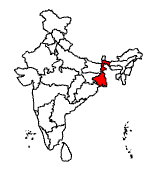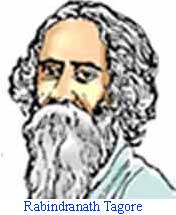
Dimdima
Online Children's Magazine from India

Dimdima
Online Children's Magazine from India
Area: 88,752 sq km
Population : 8,02,21,171About 70% of the people live in villages.
Main Language: Bengali is the state's main language. Other languages include Hindi, Santhali (a tribal dialect) and Nepali.
Capital : Kolkata, India's second largest city.
Location :
West Bengal stretches from the Himalayas to the Bay of Bengal. Its 1600-km long frontier with Bangladesh, neither natural nor well defined, has in recent years been a source of tension. It also has borders with Nepal and Bhutan.
Major Towns :
Asansol, Durgapur, Darjeeling and Kharagpur.
Physiography :
Its northern part comprises the sub-Himalayan region called the Terai, while the rest of the state forms part of the Indo-Gangetic plain. The course of the river Ganga, much of which lies now in Bangladesh, has for centuries been shifting eastward. Very little of its water now goes to the sea via its western distributaries, the principal one being the Hooghly that flows by Calcutta. The deep alluvial soil of the Gangetic plain in West Bengal is very suitable for agriculture.
The Terai region has some of the finest tea plantations in India. From the Terai, the Himalayan mountain ranges rise abruptly along the state's northern boundary. Mount Kanchenjunga overlooks Darjeeling in north-west Bengal.
Economy :
Agriculture dominates both the landscape and the economy. Rice, which requires extensive irrigation, is the leading crop in almost every district. Jute, the second leading crop, is especially prominent in the districts along the Bangladesh border and south of the Ganges.
Darjeeling and Jalpaiguri are known for their production of high-quality tea. Darjeeling also produces oranges, apples, pineapple, ginger and cardamom.
West Bengal's most industrially developed region is the area around Hooghly. Steel from Durgapur and other heavy-metal products move through Calcutta, a major port. Haldia in the south is the site of eastern India's largest oil refinery. Other important industries are shipbuilding, automobile manufacture, and chemical and fertilizer production.
The name Bengal is probably derived from Vanga, one of the many names of this region.
The Palas were the first great dynasty to rule over Bengal and ruled till the 9th century AD. In the 7th century AD, Adimalla founded the Malla dynasty, which ruled for over a thousand years in areas of western Bengal. The Mallas built some spectacular temples in Vishnupur, their capital. The Senas emerged in the 11th century AD. The period of the Palas and the Senas witnessed the growth of Bengali language. Jaidev (12th century) composed the Geeta Govinda, one of the first literary works in Bengali language.
In 1203-04, Bakhtiyar Khilji established the Turko-Afghan rule in parts of Bengal. With this, Bengal came under the control of Delhi.
In the 16th century, European traders established their trading factories in India and were attracted to Bengal. But it was the English East India Company that emerged the most successful. In 1690, they established a factory at Sutanati, which later became modern Calcutta.
In the 18th century, Bengal�s governors asserted their independence from Mughal yoke and ruled as the Nawabs of Bengal. Siraj ud Daulah the last independent Nawab of Bengal, lost the Battle of Plassey against the English in 1757. In 1765, the British obtained the right to collect revenue from Bengal, Orissa and Bihar.
From late 19th century onwards, Calcutta now Kolkata became a major centre for the Indian nationalist movement. Leading figures included W.C Bonnerjee, the first president of the Indian National Congress; Sri Aurobindo, the revolutionary leader and philosopher, and militant nationalists like Khudiram Bose and Prafulla Chaki. In 1905, Bengal was partitioned, to control the growing nationalist movement. But this led to huge protests, boycott of British goods and terrorist activities and in 1911, King George V revoked the partition.
In 1947 after independence, Bengal was partitioned and its western half became the present state of West Bengal. In the late sixties, the Naxalite movement gathered huge support amongst the idealistic urban youth. The uprising was suppressed. In 1977, Jyoti Basu headed the CPI(M) led coalition that came to power after elections. Today he is India�s longest serving chief minister in the state.
The only city in India where you can still travel by tram is Kolkata. Howrah, linked to Kolkata by the Howrah Bridge has the Indian Botanical Gardens, one of the world�s largest.
Digha, West Bengal's most popular sea resort was once called the"Brighton of the East". The island of Sagardwip at the mouth of the Ganga, hosts the Gangasagar Mela in mid-January that draws pilgrims by the thousands.
Situated in the delta region of the Ganga, the Sunderbans is home to the largest number of wild tigers in the world. It is today a national forest and a UNESCO declared world heritage site.
Malda is famous for its mangoes and silk weaving.
Murshidabad, famous for its silks was the last capital city of independent Bengal.
Kalighat is one of Kolkata's most sacred spots. Nabadwip is famous as the birth place of Chaitanya Mahaprabhu and is today a major religious centre. Mayapur is the world headquarters of the International Society for Krishna Consciousness (ISKCON).
The main attractions of Shantiniketan include the various buildings of the Visva-Bharati campus, the university instituted by Rabindranath Tagore. Shantiniketan is famous for its various festivals that include the Poush Mela in December, Maghotsab in February, Varsha Mangal as the rains set in and Sharodutsab (the Autumn festival).
Darjeeling, in the north, is one of India's most famous hill resorts. A tourist 'must' is a visit to Tiger Hill before dawn to watch the sun rise over Kanchenjunga. From Sandakphu, a trekker�s haven, four of the five highest mountain peaks in the world - Everest, Makalu, Lhotse and Kanchenjunga are visible. Kalimpong, a small hill station between Siliguri and Gangtok offers excellent views of Kanchenjunga and the other Himalayan peaks.
Bengal�s most famous festival is Durga Puja, celebrated all over the state for five days. Two Bengali sweets that are universally popular are �sandesh� and the �rasogolla�.
Last updated on :5/28/2021



Dimdima is the Sanskrit word for ‘drumbeat’. In olden days, victory in battle was heralded by the beat of drums or any important news to be conveyed to the people used to be accompanied with drumbeats.
Bharatiya Vidya Bhavan
K. M Munshi Marg,
Chowpatty, Mumbai - 400 007
email : editor@dimdima.com
Bharatiya Vidya Bhavan
505, Sane Guruji Marg,
Tardeo, Mumbai - 400 034
email : promo@dimdima.com
Dimdima.com, the Children's Website of Bharatiya Vidya Bhavan launched in 2000 and came out with a Printed version of Dimdima Magazine in 2004. At present the Printed Version have more than 35,000 subscribers from India and Abroad.